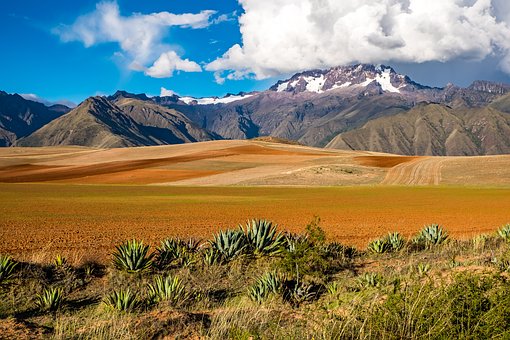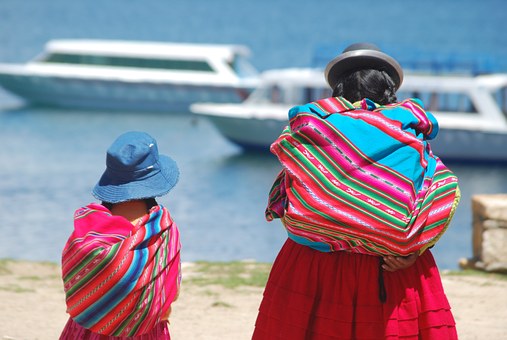Bolivia
Travel: La Paz
Carnaval
de Oruro Bolivia is a must see festival
Volunteer
in Bolivia Can Help Eco-Tourism and Conservation
Bolivia
Travel: La Paz by Melissa Reichwage
La Paz
is dizzying, not only because of its high altitude, but for its eccentric
beauty. What sets this capital city apart from the rest in South America
are the sights, sounds, and smells of streets. Lying at the bottom of a
massive canyon, La Paz is the highest capital city in the world. The buildings
cling to the sides of the canyon, and on a clear day the snowy peak of
Mountain Illimani is visible. Wander through lively markets, fascinating
museums, or chat with locals in a comedor but be sure to take your time,
not only to acclimate to the altitude but to experience the city's many
facets. You can golf at the highest golf course in the world, fly into
the highest commercial airport in the world, or ski on the highest ski
slope in the world. Just don't miss...

1.
The markets. Every inch of space seems to be taken up by Aymara women in
traditional bowler hats and voluminous skirts shouting at passing people
to buy their goods. There is a vast array of handicrafts, entire markets
devoted to faux designer labels, food and drink, bags of coca leaves, and
everything else. There is even a Witches' Market where you can find everything
you need to put a spell on a pesky hotel guest or annoying travel mate,
or you can buy dried llama fetuses to bury in the foundations of a new
house to rid it of evil spirits.
2.
The Valle de la Luna. The Moon Valley is one of the best excursions near
La Paz. The route passes through the wealthy suburbs of Calacoto and La
Florida, following the river road past some bizarre rock formations. Just
before la Luna are the Aranjuez Forest, the Ancieto Arce cactus gardens
and the Playa de Arnjuez, a popular bathing spot. Approximately 3 km from
the bridge at Calacoto the road forks, take a sharp right to Caza y Pesca
Club and Mallasilla Golf Course. Walk a few minutes east of the valley
entrance with a comfortable pair of shoes on your feet. The valley is always
much warmer than the city. Beyond the Valley is Achumani which offers good
views of the valley and glimpses of the palatial mansions of the wealthy.

3.
Sopocachi's nightclubs. Friday is the big night out in La Paz, while Thursday
and Saturday are quieter. The two most popular drinks are beer and Singani,
a spirit that is generally mixed 50-50 with Sprite or 7-up. Many of the
best bars and clubs are in the area of Sopocachi, South of Plaza del Estudiante.
For live music try Equinoccio, Café Montmartre, or Thelonius Jazz
Bar.
4.
Chacaltaya. Located 1 ½ hours from La Paz by car, Chacltaya is the
world's highest ski resort. When there is a lot of snow, the roads become
impassable. At 5,000 meters you have excellent views of Huyana and Potosí
and on a clear day, all the way to Lake Titicaca.
top
About
the Author: This guide to La Paz was written by a Bolivia travel expert
at Bolivia For Less www.boliviaforless.com available to help you custom
design your exciting Bolivia vacations.
Carnaval
de Oruro Bolivia is a must see festival by Jerry Strauss
Festivals
makes the culture of any country and what better way to enjoy the local
life and dwell yourself into the varied dances and customs by wearing the
custom masks and dresses and be one amongst the locals. Festivals mark
the joys and entertainment that people await to arrive every year and it
pleases more than locals, the outsiders who come especially to such places
to enjoy the culture of the place. The best travel destination guide is
one of the best and reliable information center where you can get varied
information on different destinations, their culture, their traditions
and varied other places of historic importance. The Carnaval de Oruro Bolivia
is one of the biggest cultural events for the city as it attracts more
than 850,000 visitors every year. The festival continues for over 10 days
and sees different celebrations in the form of parades, dances, music,
drinking and enjoying the over all atmosphere of the place.

The
best travel destination guide brings you the best and most comprehensive
guide on Carnaval de Oruro Bolivia; the carnival originates from the Andean
ancestral culture. The carnival this year is going to be held on 12th,
13th and 14th of February. The world looks over Oruro carnival as truly
unique in nature, as it is considered to be a religious celebration. The
carnival begins before 40 days before the Easter starts, it is one of the
most looked upon events for the year. The geographic locations of the carnival
according to the vacation guide states that Oruro has become a center of
distribution for terrestrial transport services that includes different
regions from Bolivia and also includes places like Chile and Argentina.
You can reach Oruro by air through Buenos Aires, Santa Cruz - La Paz, there
are regular flights from Buenos Aires to La Paz that stops at Santa Cruz
de la Sierra.
There
are varied carnivals that take place in Bolivia, La
Paz, Oruro, Tarija and Santa Cruz but the
Oruro carnival is world famous and people across the world participate
in this event with much vigor. The best travel destination guide gives
you perfect information on the monstrous costumes that are worn and the
places from where it could be rented, heavy masks are worn during the event
with eyes bulging out, the devilish masks are worn by the devils wearing
sparkling breast plates they were silk embroidered shawls around them.
While the devil dance is on, China supay - devil's wife comes out who starts
dancing in seductive dance to entice the Michael. The vacation guide recommends
to wear comfortable clothing, do not wear valuable jewelry, and get yourself
time to get acclimatized with the atmosphere of the carnival.
top
|

